I’ve never been a goal-oriented climber so I don’t really see the point in recording my climbs or hyping them up. I don’t really care that much about “sending” routes and I definitely don’t give a fuck if anyone knows when I do send something. I don’t have an 8a.nu scorecard. I don’t hashtag on Instagram. And I’m not on Facebook. I guess that makes me a shitty Millennial …
I do, however, enjoy reading the “Day I Sent” series on Evening Sends. I’ve noticed many of these stories follow a similar storyline. It’s the classic “Hero’s Journey,” only with bolts and kneepads. The main climber finds the perfect project, battles both physical and psychological hurdles, comes to some kind of internal peace with the whole process, and eventually sends the motherfucker. End of story.
Part of what makes these stories enjoyable to read is that hard routes can bring out some really important, but not always obvious lessons. Routes ticked, cruxes overcome, and summits achieved can be super meaningful, but they’re also not the most important things in life.
The true, lasting meaning, we like to say, is found in the friendships and partnerships that we build while pursuing our climbing goals.
Over the last few years, however, as I’ve watched too many friends go to the mountains only to never return, I’ve realized something painful. It’s not just the memorable summits and crux moves that are fleeting. Friends and climbing partners are fleeting, too. This is the painful reality of our sport, and I’m unsure what to make of it. Climbing is either a beautiful gift or a curse.
This is a story about the day we sent Logical Progression, a big-wall route in Mexico. The route was amazing, but it wasn’t all that hard. The experience was incredible because I was with three good friends: Chris Kalous, Kyle Dempster, and Justin Griffin.
There’s no easy way to say this, but half that team is now dead.
Justin died in Nepal in 2015. And Kyle, along with his partner, Scott Adamson, vanished while climbing on a remote peak in north Pakistan a year later.
I think about Kyle and Justin all the time. Their absence from this world is felt by so many who are left in a wake of confusion, anger, and frustration.
In many ways, I am still processing what has happened to my dear friends. Waves of sadness overwhelm me at times, making it hard to stand up or focus. At other times I am able to think only of the enchanting adventures, contemplative conversations, and the simple yet enriching moments we shared as friends. These pendulum shifts between various emotions will never go away, as I am starting to learn.
I see both light and dark in climbing. Through this recognition, true learning begins and a full awareness of the brevity of our time becomes clearer. It’s difficult to accept the fact that we cannot control everything in life, yet we still try, and maybe our path changes to something totally unexpected.
I am still in the process of finding my own path, and I’d be lying if I said these deaths haven’t affected its direction. How does climbing fit into “real life”? If we only take the surface level experience—endlessly chasing the next hardest project, the next most futuristic alpine objective—then, in my opinion, climbing becomes too much of a selfish pursuit.
Maybe the most genuine aspects of any tale are the sputterings and the silences, the acknowledgments of failure, the glimmerings in the dark. And maybe one genuine reason to try to share our stories about days we actually send something, when we are alive and at the height of our powers, is to try to bring back what’s past, lost, or gone.
Perhaps by doing so, we might find some light illuminating a new way forward.
It’s night, and Kalous and I are driving somewhere in the foothills of the Sierra Madre mountains of Sonora, Mexico. Maps, candy wrappers, and rollies are scattershot across the dashboard. We have been pushing the pedal with relentless enthusiasm since the Nogales border crossing just south of Tucson.
“Melissa,” my van, has already suffered some road injuries with several cracks to the front windshield and a dented rear bumper. The road is so dark that even the yellow median lines seem to fade in and out of the headlights. Massive potholes devastate my shocks and jostle my entire body, adding to the paranoia I feel about driving at night through narco country. After 17 hours on the road, I am starting to feel like I’m on drugs, and not the good kind. My head buzzes, and my eyes are having a hard time distinguishing between the shadow-life and reality.
Looping around a large switchback, we are suddenly confronted with the blinding floodlights of a military roadblock dead ahead.
“This is so fucked, this is deeply fucked,” Kalous whispers as I slow down and start to pull over.
Just behind us are Kyle and Justin, who are in Kyle’s van, “Pegasus.” I hear them hit the brakes, and their headlights disappear as they pull right up behind me.
A wooden officer’s shack is illuminated by candlelight. Bottles of tequila and Carta Blanca lay on the ground around the entrance. Five armed police pour out of the shack, and quickly approach our vans, rifles in hand. The men circle our caravan, establishing a perimeter of space. One comes over to my window.
“Gringos!” he says, seeming surprised. There is a strong scent of tequila on his breath. “A donde vas, gringos?”
Just as I was about to offer up an answer in my own piss-poor Spanish, I see that Kyle and Justin are already out of their van. They are walking among the guards, calm as cucumbers, handing out packs of Marlboro Reds and porno magazines.
The guards look pleased with the offering.
I follow suit and step out of the van. Kalous, perhaps being a couple decades wiser than the rest of us, seems hesitant. He lingers for a few moments then joins the party.
Kyle lights a cigarette. He takes a long drag, then blows a set of impressive smoke rings that get the policemen to loosen up.
“We are from Utah and Colorado and have come a long ways to see your beautiful country,” Kyle casually says in Spanglish.
“And for the cheap beer!” Justin adds.
We see a few smiles crack across the hardened faces of the policemen. Some of the men are wearing black ski masks because they don’t want potential enemies who are driving through to see their faces. Some of the masks come off and Kyle continues to converse with the policemen as if they were long-lost friends. He gives a few of the most curious policemen a tour of his built-out Sprinter. Meanwhile, Kalous, Justin, and I explain our reasons for traveling to this remote part of Mexico to several of the clearly inebriated guards, who are swaying drunkenly while cradling their guns in their arms.
Thanks to Kyle’s gifts and his smooth confidence, we reach a surface level understanding with the police that we are good people. The police are actually quite impressed that a group of Americans was driving at night through one of Mexico’s most notorious drug-trafficking regions. They are also concerned about our safety and recommend that we stay in the next town, ten miles down the twisty mountain road.
“Vaya con dios,” the head policeman says, and shoos us away with a rolled up porno mag.
Engulfed in darkness once again, we drive toward the small town of Tecorpia, unaware of what lay ahead.
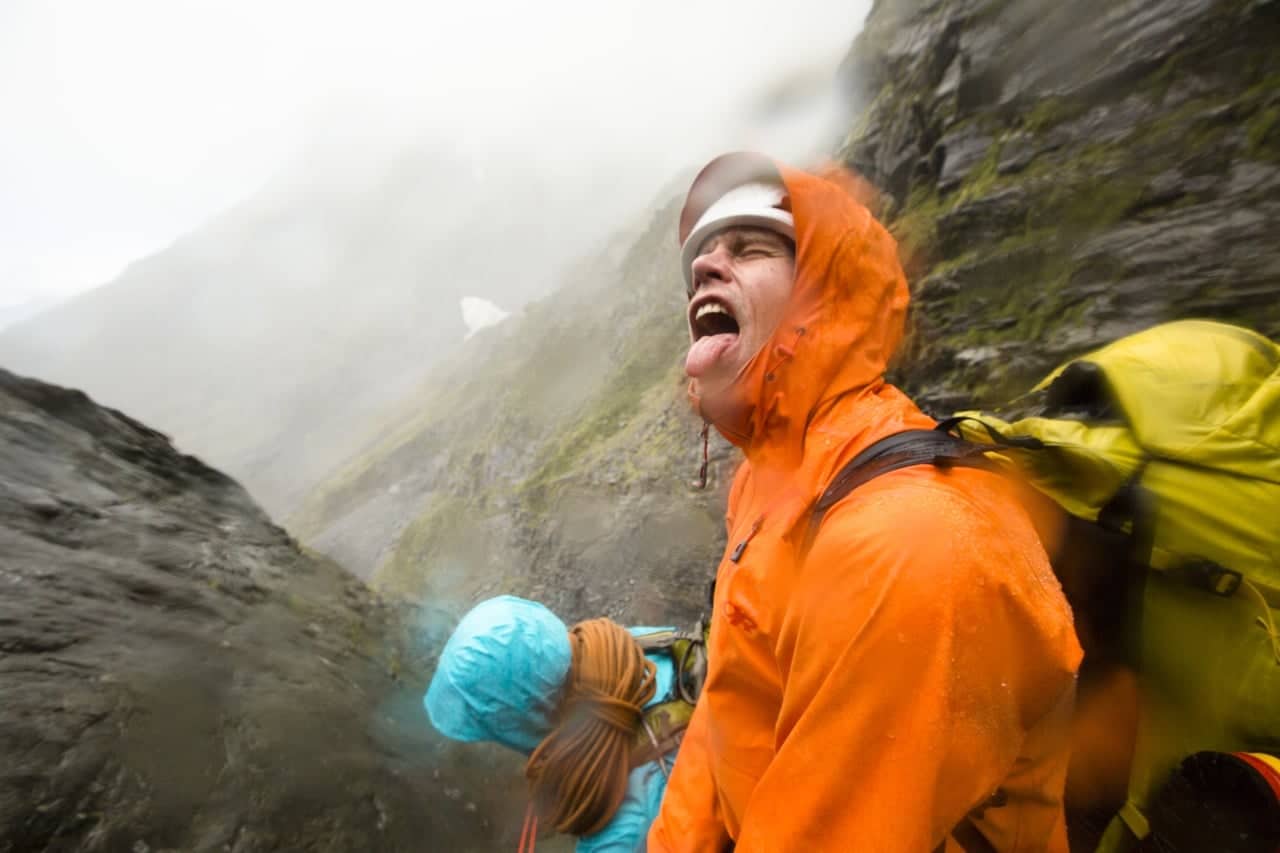
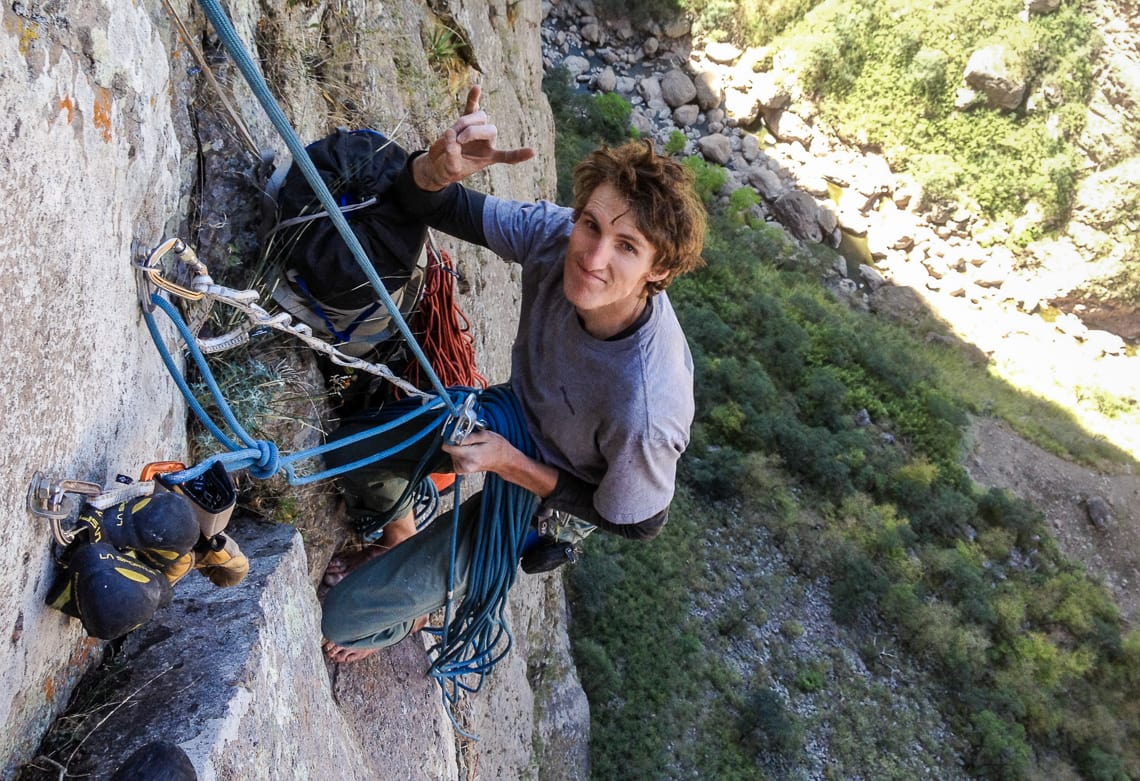
Three months prior, I was in the middle of my annual Christmas light-installation grind in the suburban hell-scape called the Front Range of Colorado. Every November my friend and climbing/business partner Jesse Huey and I would drop everything to “cash in on the joy” by adorning suburban mansions with Christmas lights. It was the exact kind of brutal, dangerous work that would suit an alpine climber, so long as we could ignore the fact that we were contributing to one of the most obscene spectacles of American consumerism ever invented.
From 6 a.m. to 6 p.m., Jesse and I dangled off roofs and tresses with a clusterfuck of C9-LED light stringers hanging from every part of our bodies. One time, when I couldn’t find a solid roofing anchor, I filled my Grade VI haul-bag with bottles of water to create a counterweight on the opposite side of the house while I traversed a 40-degree slope of glaciated shingles. We worked 12-hour days nonstop, ate like shit, and drank most nights. Occasionally, we’d find time to flail in one of the many Front Range climbing gyms.
I once spent eight hours in a cherry picker with a homeowner named Rocky Bliss. We strung lights all over his 45-foot cottonwood trees, a spectacle that was sure to put all of his neighbors’ Christmas lights to shame. Mr. Bliss could hardly contain himself.
“It’s you and me up here, Hayden, getting closer to God!” he said without a hint of irony.
Jesus Christ, get me out of here! I was so ready for a climbing trip when all this “joy-spreading” was done.
Tough as it was, I knew this work would soon be rewarded with the ultimate amount of freedom. I could grind hard for three months and make enough cash to fund my climbing “fix” for the rest of the year. I used Christmas light money to get me abroad, from Patagonia to the Himalayas to the Canadian Rockies, as well as the interim road-trips all over Europe and North America.
Over the actual holidays—a reprieve for us Christmas-light elves, meaning, the time between the actual light installation and the subsequent retrieval of those lights—we hatched a plan for a Mexican adventure.
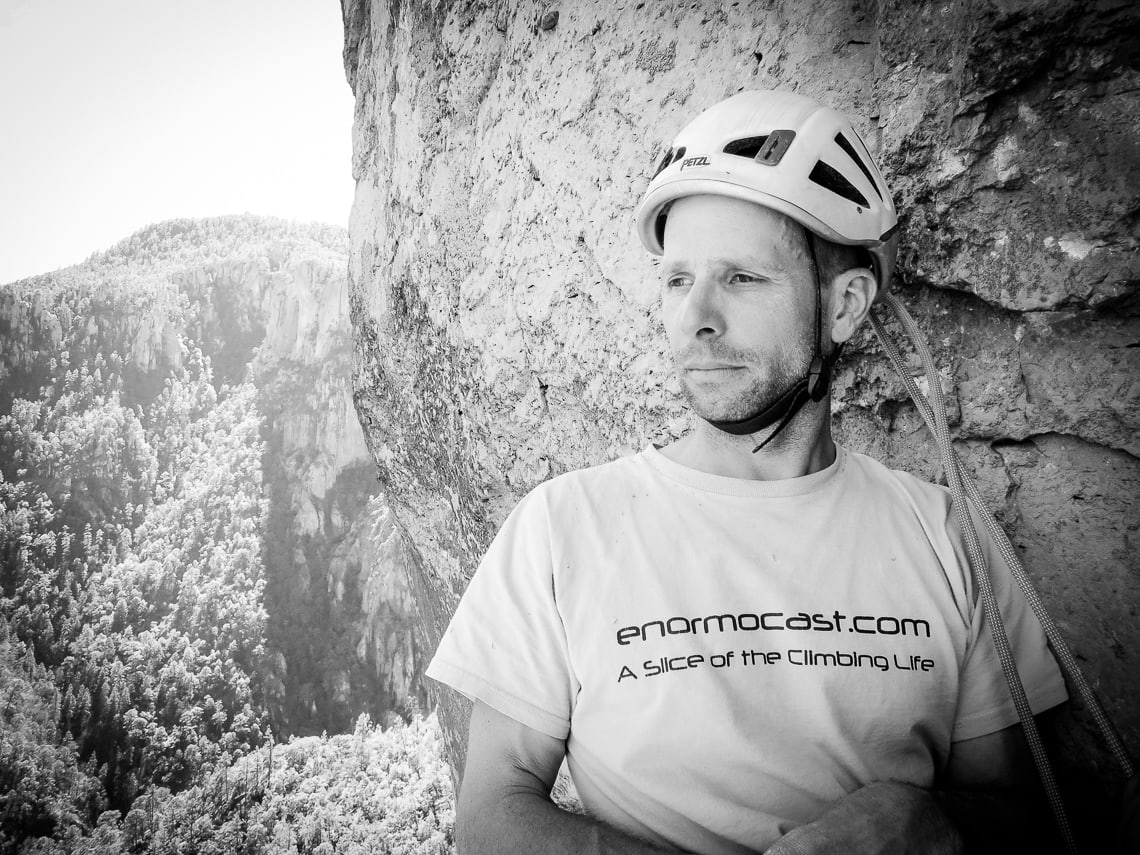
I was visiting my family and friends in my hometown of Carbondale, Colorado, and linked up with Chris Kalous. You may know Kalous as the voice of the Enormocast, but to me, he was actually first my high-school English teacher. He subsequently became one of my closest friends and climbing partners.
Earlier that week, I’d received an email from my best friend and longtime alpine climbing partner, Kyle Dempster. The email was characteristically sparse; it simply said, “Mexican road trip … you in?”
Over some beers, I casually mentioned the idea to Kalous.
“Where would you wanna go?” he asked. Well, I hadn’t actually thought much about that part. After a season of Christmas lights anywhere sounded good.
With Kyle and Kalous both on board, we just needed a fourth climber, so Kyle invited our mutual friend from Bozeman, Justin Griffin. This was a sweet crew!
Now, all we needed was an actual climbing objective, which was in some ways the least important part of the equation.
Ultimately, we decided on a 1,000-meter rhyolite big-wall known as El Gigante, located in the heart of the Copper Canyon in northern Mexico. Certainly, El Gigante’s best-known route is Logical Progression (VI 5.13a), which Peter Baumeister, Luke Laeser, and Bert van Lint established in February 2002.
At the time, the American/German team received a rash of criticism for the style in which they opened their route. They rap bolted all 3,000 feet of the limestone wall using power drills. Never before had such a prominent feature been subjected to such egregious sport-climbing tactics. Alex Huber vowed to chop the route, and a “debate-piece” was published in the American Alpine Journal in 2003 shortly after the first ascent.
In 2007, the wildly talented French team of Arnaud Petit, Stéphanie Bodet, Titi Gentet, and Sylvain Millet made a near onsight of the route. They called it, ”Chef d’oeuvre.” A masterpiece.
Alex Honnold and Sonnie Trotter made an impressive one-day free ascent of the route in 2010 and raved about the route. With such high praise and even a healthy bit of ethical controversy—a part of this sport with which I am all too familiar—Logical Progression became our main objective.
Many climbers associate my name with the clouded controversy that surrounds Cerro Torre. In 2012, Jason Kruk and I climbed the Southeast Ridge of Cerro Torre without using any of Cesare Maestri’s infamous, ladder-like bolts, which he installed in 1970 using a 500-pound gas-powered compressor. Maestri drilled his way to the top, without any regard to the natural features of the mountain. Climbers have debated Maestri’s bolts for decades. Over the years, as alpine climbers’ skills, vision, and talent increased, so did the call to restore the natural challenges of this special mountain. After climbing Cerro Torre without the bolts, and seeing firsthand the outrageous nature of their placements—and understanding the history of the debate—Jason and I decided to remove a majority of the bolts on our way down.

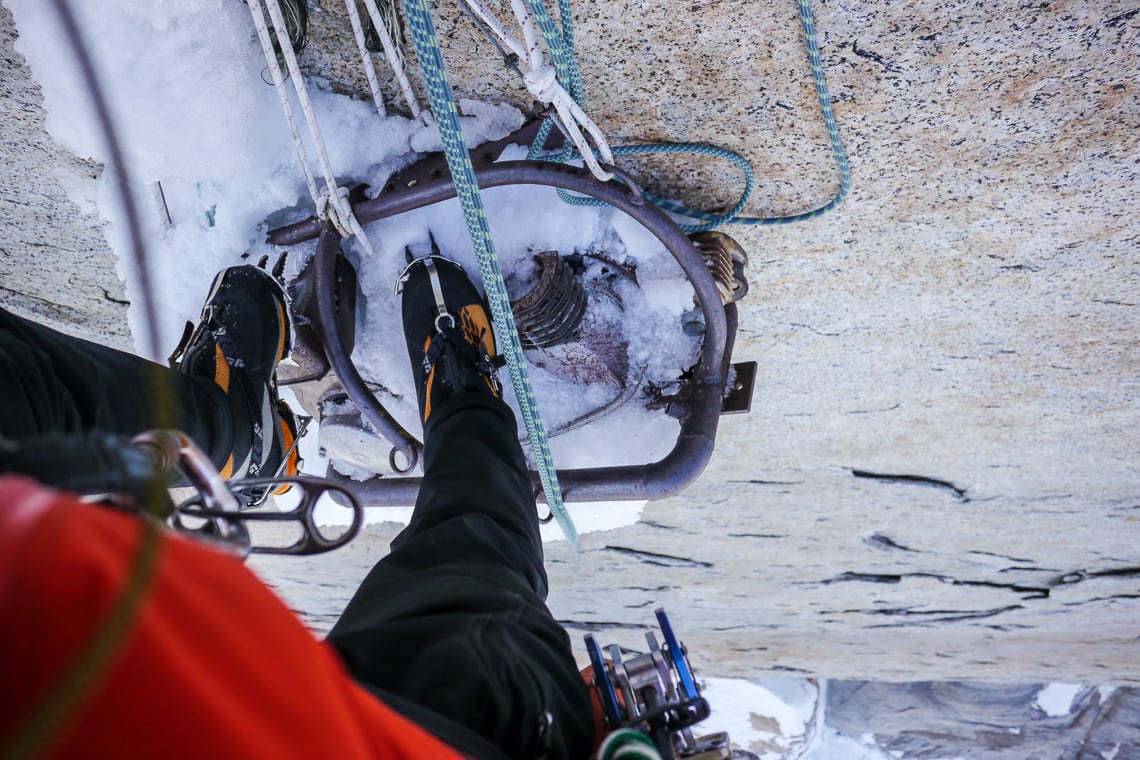
You might think a guy like me is some kind of crazy anti-bolt zealot. If so, you might also think that I’m a hypocrite for choosing an objective like Logical Progression, which sports nearly 1,000 bolts that were placed on rappel.
I don’t think bolts are inherently evil; they’re just little pieces of metal. More specifically, Cerro Torre, an ice-covered alpine climb, is very different than El Gigante, a jungle big-wall. The bolts that were installed on Cerro Torre were completely unnecessary, while the bolts on El Gigante are appropriate.
I spent my entire youth reading everything about our sport’s history that I could get my hands on, not to mention discussing the nuances of climbing’s ethics with my dad, a former world-class alpinist, and all of his fellow world-class alpinist buddies when they’d come through town.
More importantly, I’ve tried to make opinions about climbing ethics based on first-hand experiences—not through Internet forums. That seems to be a rare thing these days. Most climbers my age seem to care more about checking their 8a scorecards and being addicted to social media than they do about learning our sport’s history. Many climbers my age couldn’t tell you who Walter Bonatti, Joe Tasker, Jerzy Kukuczka, and Bernd Arnold are, but they do know the latest hashtag marketing campaign.
Mostly, I was interested in checking out Logical Progression to see if it lived up to the hype, or if it was another “murder of the impossible” type of situation. I think it’s important to keep an open mind, get off the internet, and just go climbing.
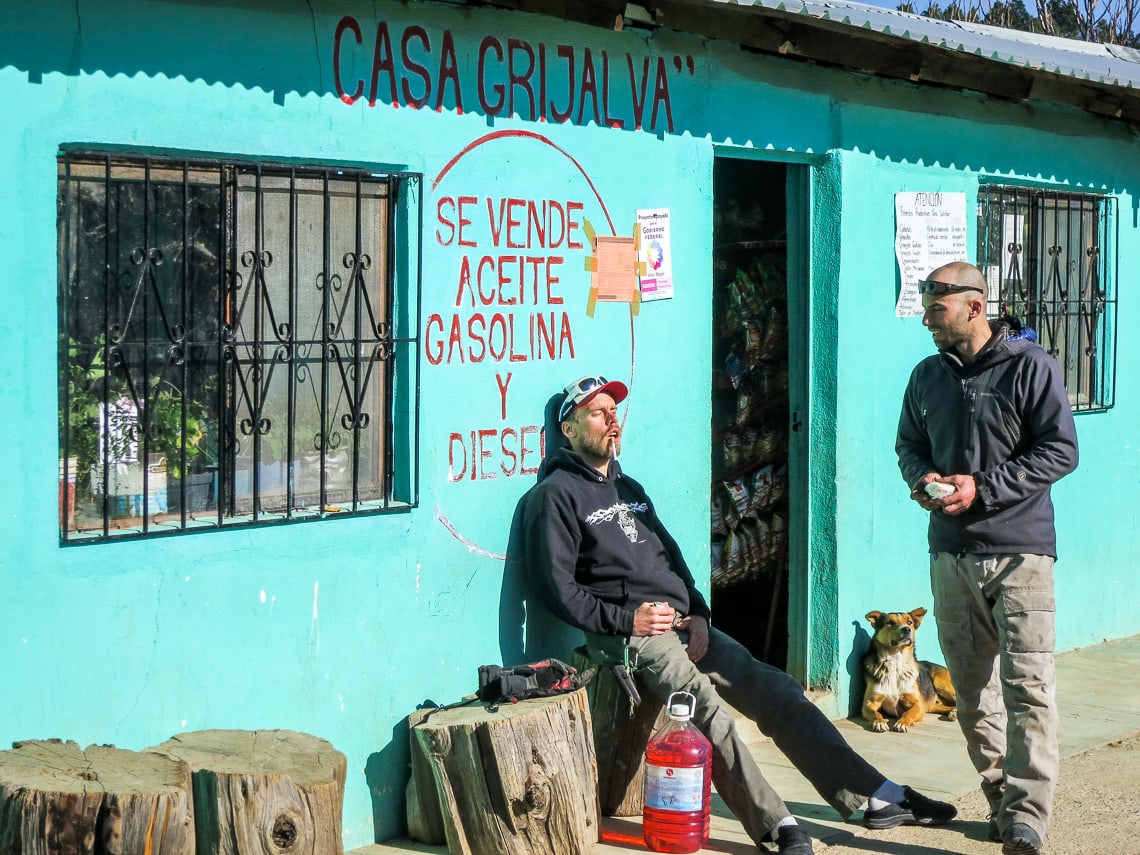
We arrive in the dusty main drag of Tecorpia at 2 a.m. and, of course, as gringos, we thought it would be a great idea to stop for some tacos and cervezas. As we creep down the main street looking for some kind of late night snack, an armored truck full of masked policemen passes and stops at a nearby house. All of the police jump out from the cab of the truck, guns pointed at the house as they approach. I immediately flip Melissa around and speed out of town. Tacos at 2 a.m.? Tremendous fucking idea!
We bivy in the parking lot of a well-lit gas station in Tecorpia. By morning, we are rolling cigarettes and sipping coffee, debating the night’s close calls. Between the police-checkpoint fiasco and our encounter with the masked gunman later the night, we all needed to blow off some steam.
“I honestly can’t believe we were driving that late at night!” Kalous says sternly, looking at the rest of us. “Pure ignorance and stupidity!”
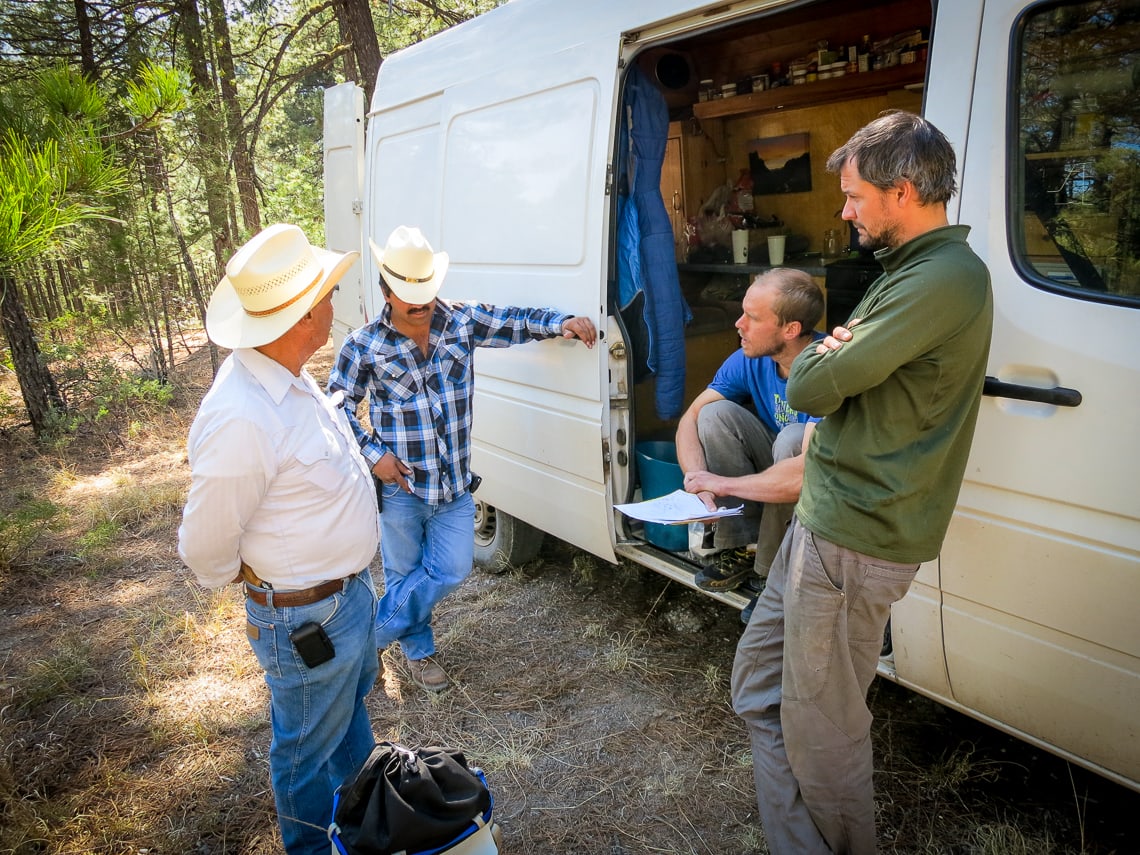
Kyle starts to laugh while Justin and I gaze into the morning light pretending we didn’t hear Kalous.
“You’re right,” I finally say quietly. “At least we off-loaded those packs of Reds and porno-magazines. I was starting to feel uncomfortable with all that in the van!” Justin smirked. We laughed. Back to the basics.
We start driving and soon reach the signs for Basaseachi National Park and Copper Canyon. Thank god, we made it. We pull into a deserted parking lot with a single taco stand. From the parking lot, we can only see into one aspect of the canyon but the relief of the walls is obvious and impressive. Quickly we gather our bearings and locate the Rancho San Lorenzo, which we heard was the best spot to camp.
As our caravan enters the ranch, we see an older Mexican leaning against a fence. His name is Fernando, and he is wearing a cowboy hat and a tucked-in, baby-blue button-snap shirt that reveals his beer belly quite well, which protrudes over an enormous belt buckle.
“Que pasa, gringos,” he says, lighting a cigarette and adjusting himself in his well-worn blue jeans.
In painful, broken Spanish, Chris attempts to describe our goals, wants, and needs as plumes of smoke are billowing out from under the brim of Fernando’s cowboy hat.
“Ha-ha! No problem, gringos!” says Fernando, laughing. “I speak English and of course you can stay at my ranchero. Your vans will not make the road to El Gigante so I can arrange a driver for you, if you would like?”
Perfecto! That evening we sit around a campfire and share stories of our travels with our new friend over tequila.
“In Mexico, you must take responsibility for yourself and your family because the law doesn’t exist,” Fernando says, lifting his shirt, revealing a pistol.
“We live in completely different worlds,” Justin remarks and sips a beer.
We fall into silence and just enjoy each other’s company and the remoteness of our position.
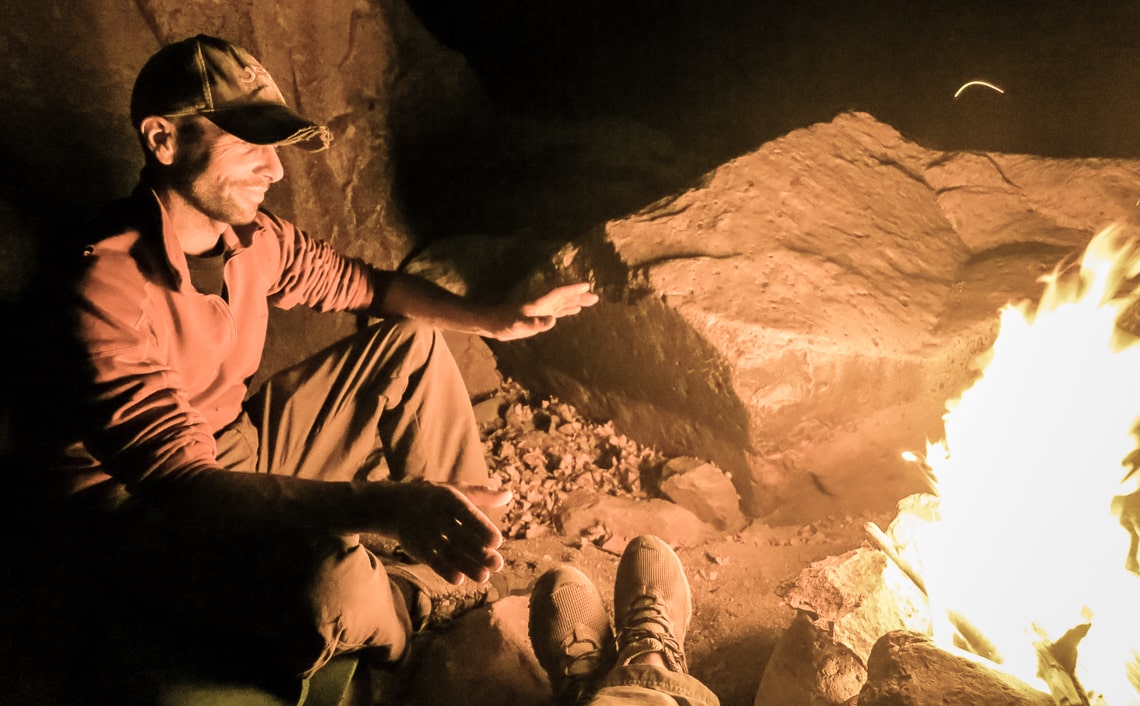
Four days later, we have adjusted to the tropical climate, acquired a week’s worth of supplies, and are now bouncing in the back of a ruby-red 1987 Chevrolet pickup truck into the jungle. After nearly two hours the road finally ends in a densely forested pullout, with not a wall or canyon in sight.
Our friend Andrew Burr had drawn us a map on a napkin of the complex approach, which is actually a descent from the canyon’s rim down jungle-choked gullies to the base of the wall. Kyle turns the map several times in an effort to orient our location.
“We don’t need this stupid thing,” he says, crimping the napkin and throwing it into the woods. “It’s more confusing than it is helpful.”
I first met Kyle on top of El Cap in Yosemite in the spring of 2009. Kyle had just topped out some massive aid solo and resembled a dried-up sponge. Wolfmother blared out of his speakers and his energy was pulsing. Kyle’s pronounced chest made him seem almost un-human-like, or at least un-climber-like. I started to call him the Silverback not only for his strength but also for his attitude. The silverback gorilla walks independent and silent.
Kyle often spoke about the power of solitude, the importance of self-reliance, the impact of third-world travel, and the significance of Black Sabbath. He told hair-raising tales from a trip to Pakistan, where he nearly completed an audacious solo of the West Face of Tahu Rutum. He had spent over 20 days on the wall, alone, before retreating in a storm.
Kyle and I climbed a bit in Yosemite as well as in his home mountains, the Wasatch, just outside of Salt Lake City. Our first international trip was to Pakistan’s Charakusa Valley in 2011, where we attempted the unclimbed East Face of K7. We returned the following year with the Slovenian power-house, Urban Novak, to finish what we had started. Our line up the East Face of K7 offered everything you would ever want or expect on a big, alpine climb, from waist-deep snowing slogging, to scrappy granite mixed climbing with poor protection, ice funnels that dripped like candle wax down the mountain, spindrift avalanches, belly aches from dehydration, extremely long periods of movement without sleep or pause, and a bond that only comes from traveling through this terrain with your partners. All three of us connected in a big way on K7. In retrospect, this climb represents everything that I love and aspire to within climbing. It was a success beyond our new route and summit, and Kyle was a major reason why.
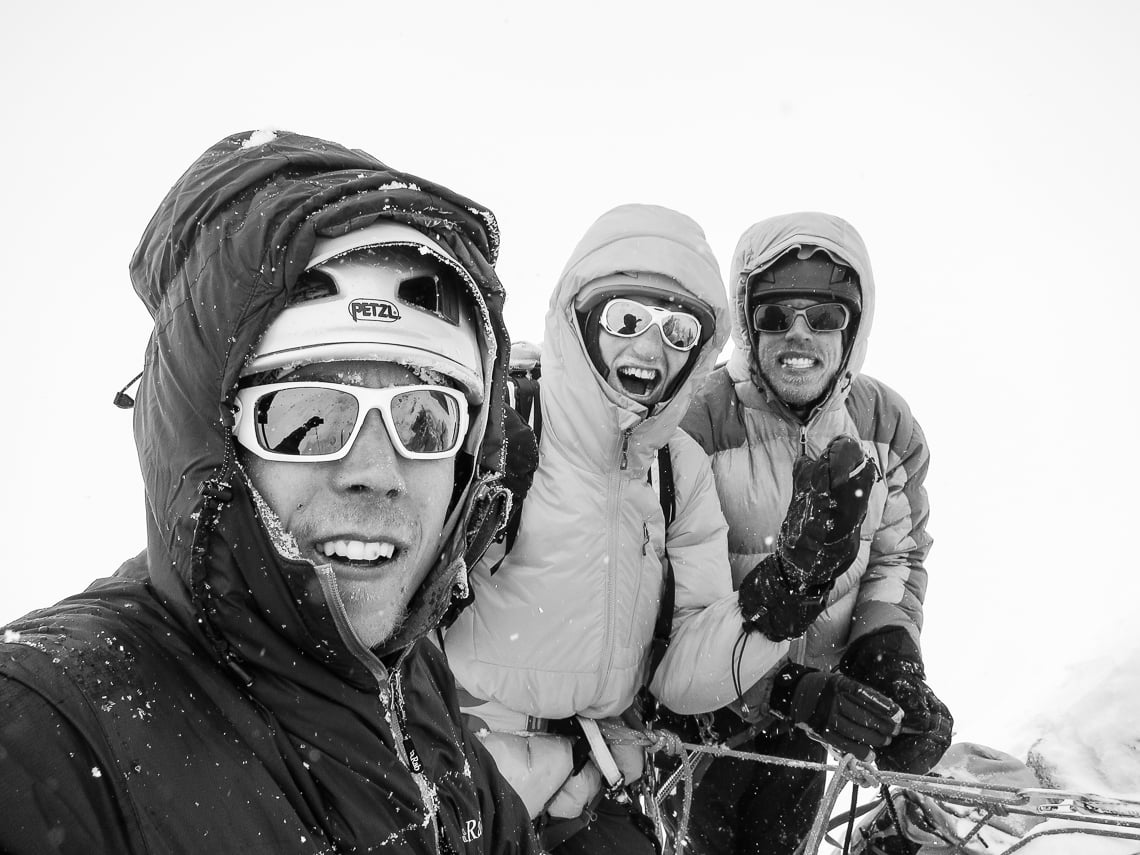
I roll off my thin foam pad into the dirt and pine needles. My head throbs with a Tecate hangover. Justin is already awake, making coffee and scrambling eggs.
“This will make you feel better,” he says, handing me a cup of coffee. “If you are gonna be dumb, you better be tough.”
We pump ourselves with enough caffeine to trounce our hangovers or at least keep them at bay. Our plan was fairly straightforward; Kyle and Justin would climb together as a team one full day ahead of Kalous and me.
Kyle and Justin are packing “disaster-style,” which basically means they are blindly throwing stuff into a haul-bag with no concept of what they actually have for the climb. Justin is a master of the “No Plan” plan.
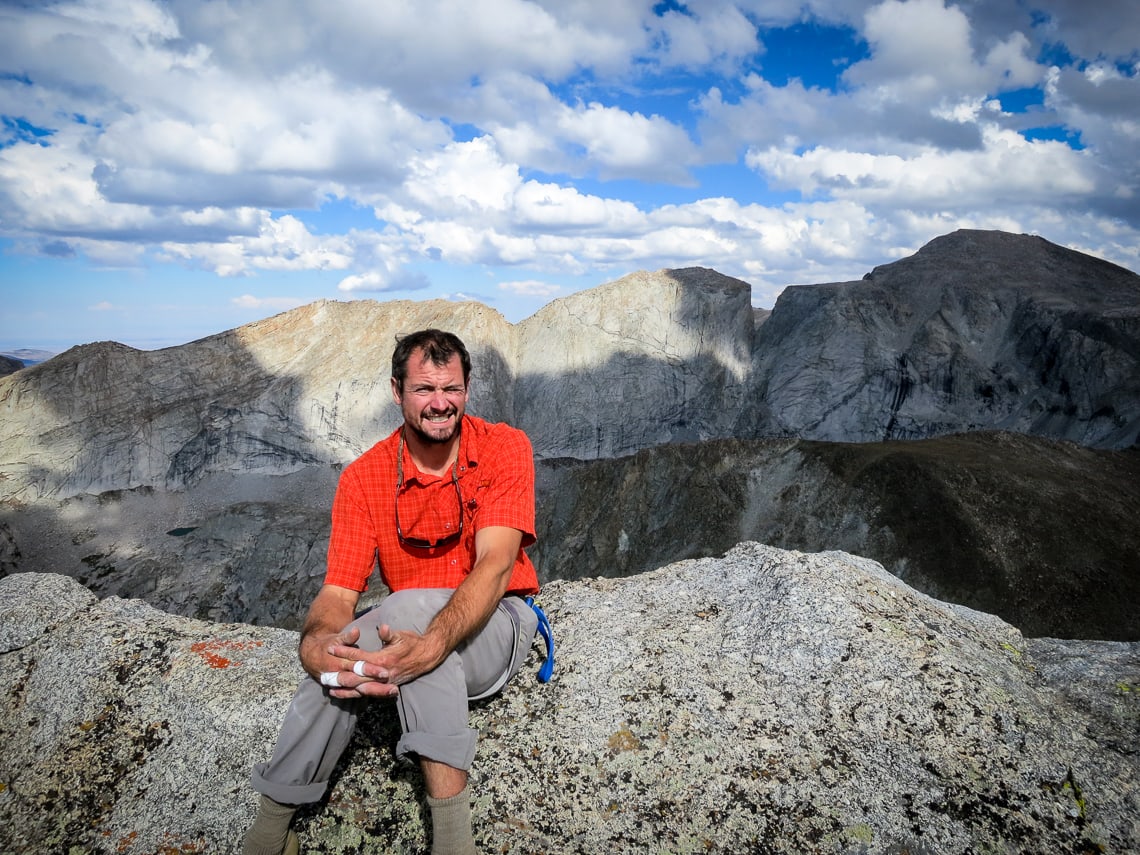
Kyle introduced me to Justin on a bitterly cold day while ice climbing in Hyalite Canyon just outside of Bozeman, Montana, in 2011. Justin’s lanky frame even gave my awkward stature a run for my money.
As the day grew colder, our laughter got stronger. That evening, Justin’s southern-drawl crept out as the beers went down. Justin had lightness to his step, a calm demeanor and a jovial smile that pierced the room.
In 2013, Kyle, Justin, and I established a new free variation to an old Jeff Lowe aid line on Haystack Peak in the Deep Lake area of the Wind Rivers. We spent ten days living in the mountains, eating bacon straight off the cast iron and shooting whisky over truths and lies. We climbed our brains out. Our route that we later dubbed, Lowe-Spark, had several very techy 5.13 pitches and a stack of 5.12. More importantly, we felt a certain spirit, a palatable connection that transcended the climbing.
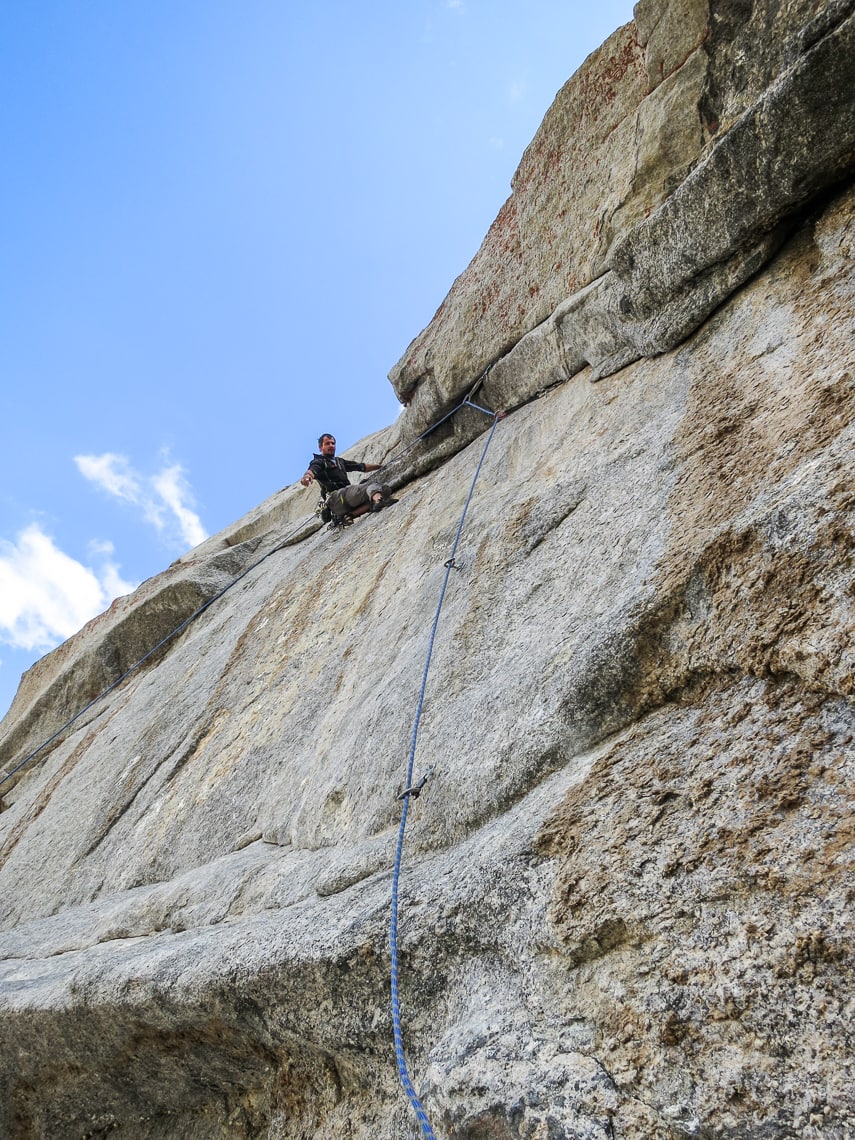
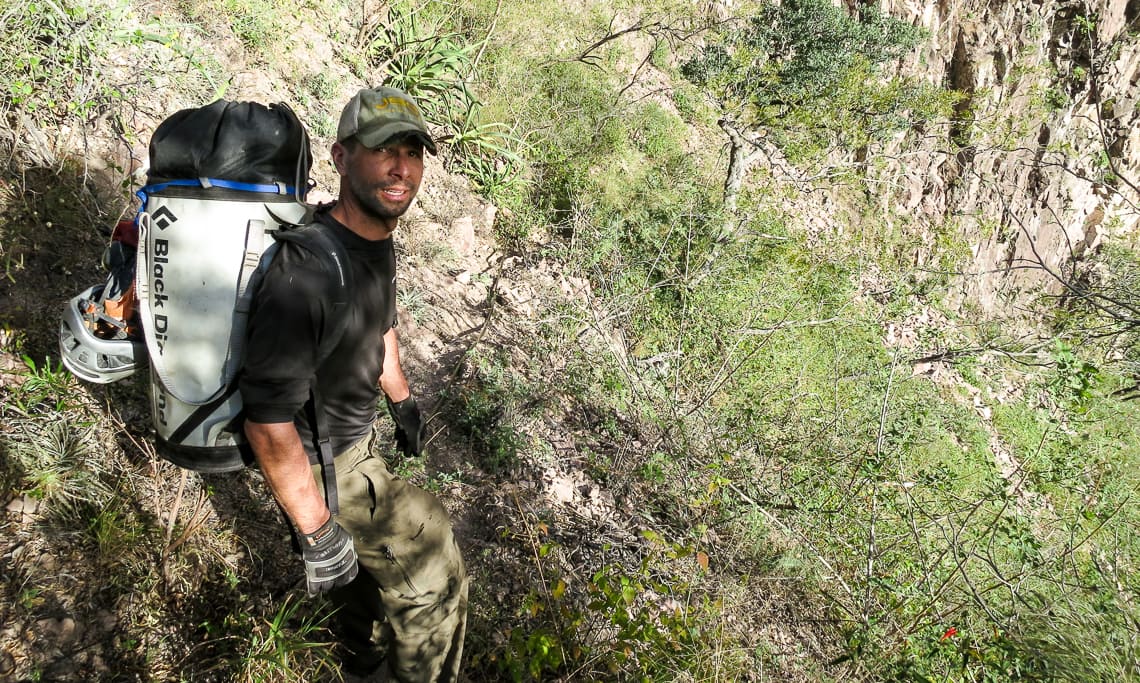
A day after Kyle and Justin left, Chris and I are stumbling down the convoluted, loose gully, with sketchy down climbing and heavy bushwhacking. We discover that there is a small-scale marijuana grow-op at the base of the wall. As we cautiously approach the grow-op I happen to notice that Kalous—dressed in army-green pants, a black long-sleeve shirt, and a dirty trucker’s hat—looks like a DEA agent.
“Fuck man! You are going to get us shot looking like that!” I say, joking as we thrash our way to the base of the wall. We had planned for two nights on the wall. Kalous had packed our bags like a mother sending her firstborn off to grade school. Everything was in order. Even the crusts had been cut off our sandwiches.
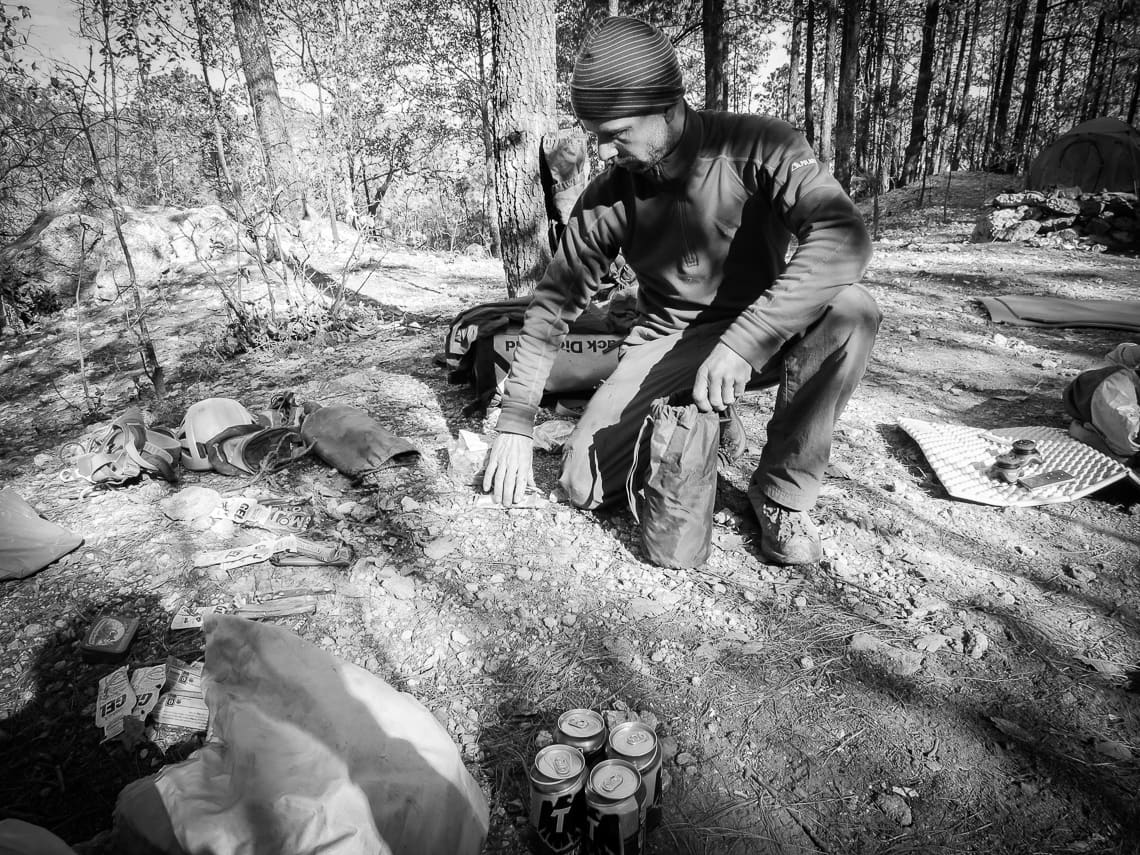
Kalous is a modern renaissance man. His repertoire of skills, passions, and jobs include podcasting, rebuilding car engines, playing music, teaching high school, guiding in Estes Park, painting houses, and climbing every kind of stone, in all styles. He’s one of the best crack climbers I’ve ever seen.
I really got to know Kalous through listening to Aretha Franklin, Dusty Springfield, the Temptations, Herbie Hancock, Soulive and Miles Davis. I was probably thirteen when I joined his after-school Blues/R&B band. I played the saxophone and was obsessed. Our little group would get together two days a week for rehearsals and we even won the annual battle of the bands several years in a row.
Kalous spoke to us like we were adults, which ultimately bridged the gap between the student and the teacher. We started hanging outside of the band and with my fresh interest in climbing, Kalous became one of my first climbing partners. Our early trips to Indian Creek were mind-blowing for me as I watched him dispatch pitch after pitch like a knife cutting through butter.
He has most recently added a new skill to his repertoire: parenting. He’s a proud father of his son, Miles.
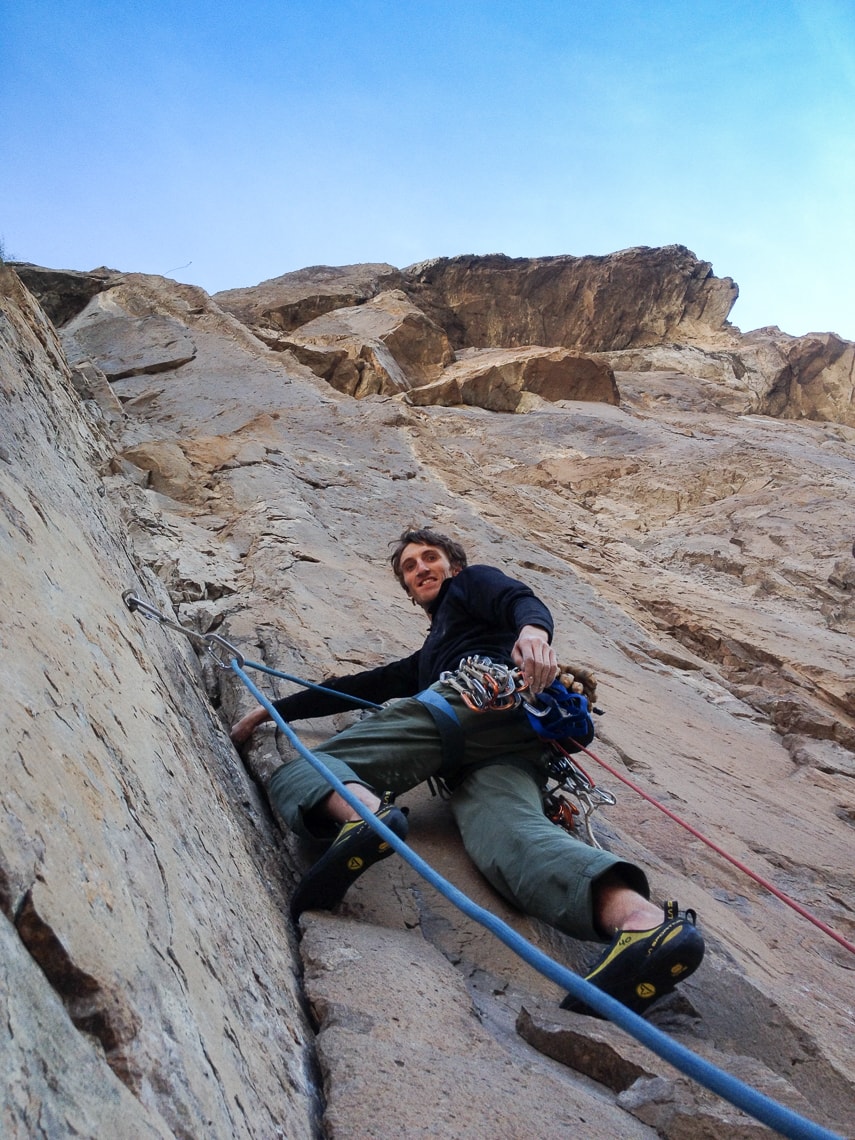
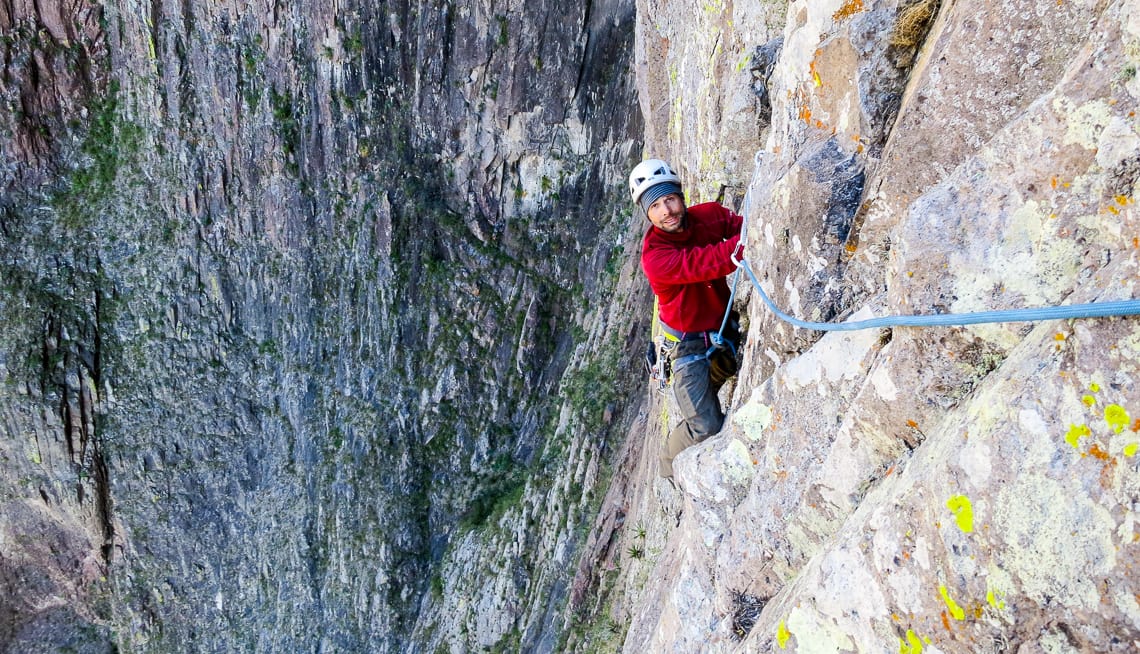
The first few pitches of the Logical Progression feel awkward. We need to adjust to the rhythm of the wall. We swap leads and gradually fall into an enjoyable pace. One of the most attractive attributes of Logical Progression is the fact you don’t need a single piece of traditional gear for the entire 1,000 meters; a 60-meter rope, 20 draws and a few slings will do. The first nine pitches are relatively easy. There are a few 5.11+ sections, but mostly it’s consistent 5.10 terrain to gain the “Tower of Power” bivy on top of pitch nine.
I cast off on pitch ten, the first hard pitch of the route. A steep corner and thin flakes add pump-value as I gain the crimpy 5.12+ cruxes. My fingers feel strong, my mind is at ease, and I climb with a looseness that allows me to relax on the small holds. El Gigante casts an impressive shadow as the afternoon light fades into dusk. Kalous follows the pitch clean.
Below pitch eleven, I take a few deep breaths before attempting the first 5.13 pitch of the route. My arms feel slightly more tired than I would like so I climb faster and faster. The blocky rhyolite has the shape and texture of a Rubik’s Cube, yet the movement is perfect. I let out a scream as I pull the steep crux, skipping the clip. I look down and see the rope snaking into the void. I clip the anchor and fall into my harness. We fixed our ropes and rappelled back to the Tower of Power bivy for the night.
Morning comes all too soon and a cold wind shakes us awake. Back at it! I love wall climbing! Swinging leads and with a dialed-in system, we can just relax and enjoy the climbing exposure. Each pitch is more stunning than the last.
Every so often we come across Kyle and Justin’s chalk. I wonder what kind of experience are they having? We reach a short band of rotten rock with a supposed 5.12 pitch. I leave the belay with a hint of a too-cool-for-school attitude. I am promptly put into my place as I whip all over the pitch.
“You’re no Sharma, buddy!” Kalous ribs. Finally, I manage to send the pitch in one clean go. Here’s what I know: you can’t sell sand to Arabs and you can’t tell me that that pitch is only 5.12! Nails!
We reach the top of pitch eighteen as the sun sets. We crawl into the infamous “Critter Bivy” for the night. Cracking beers hurt my fingertips but the luxury of a few coldish beers in the vertical word is unmatched. We jam out to a new Daft Punk album under a clear night. Our conversation drifts in and out but the tunes stay constant until we lay our heads down.
I wake up at 6 a.m. to find a spider the size of child’s hand crawling on my sleeping bag. I have a mild case of arachnophobia, by the way. I try to stay calm as I flick the eight-legged devil off my sleeping bag. Perhaps it is an ominous sign sent from the Tarahumara—the indigenous people of this region, whose legendary reputation as endurance runners has been recently romanticized in a number of books and articles.

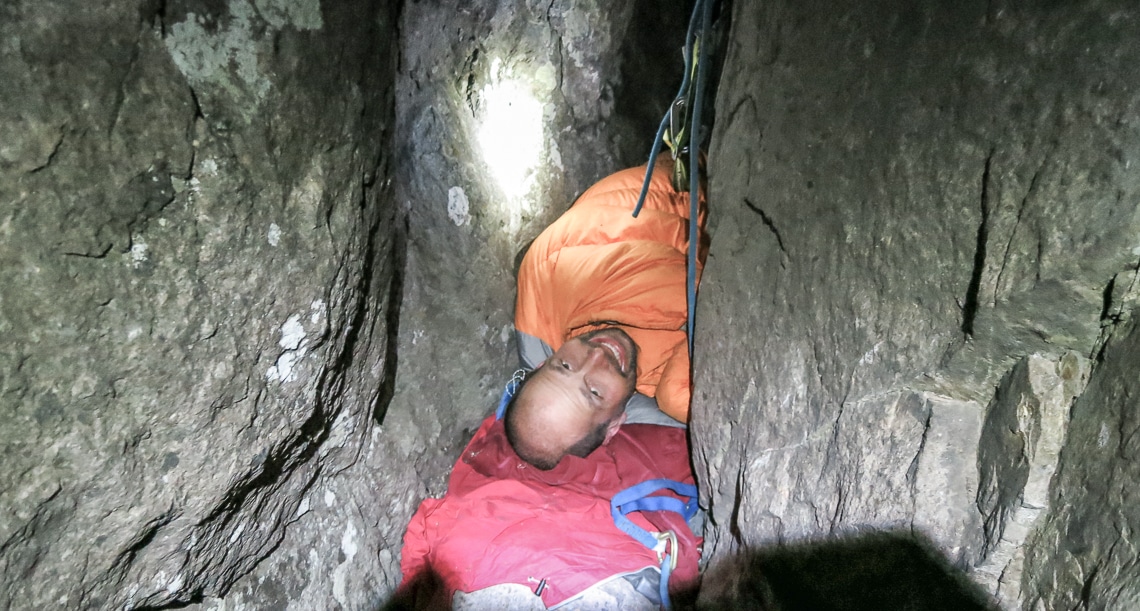
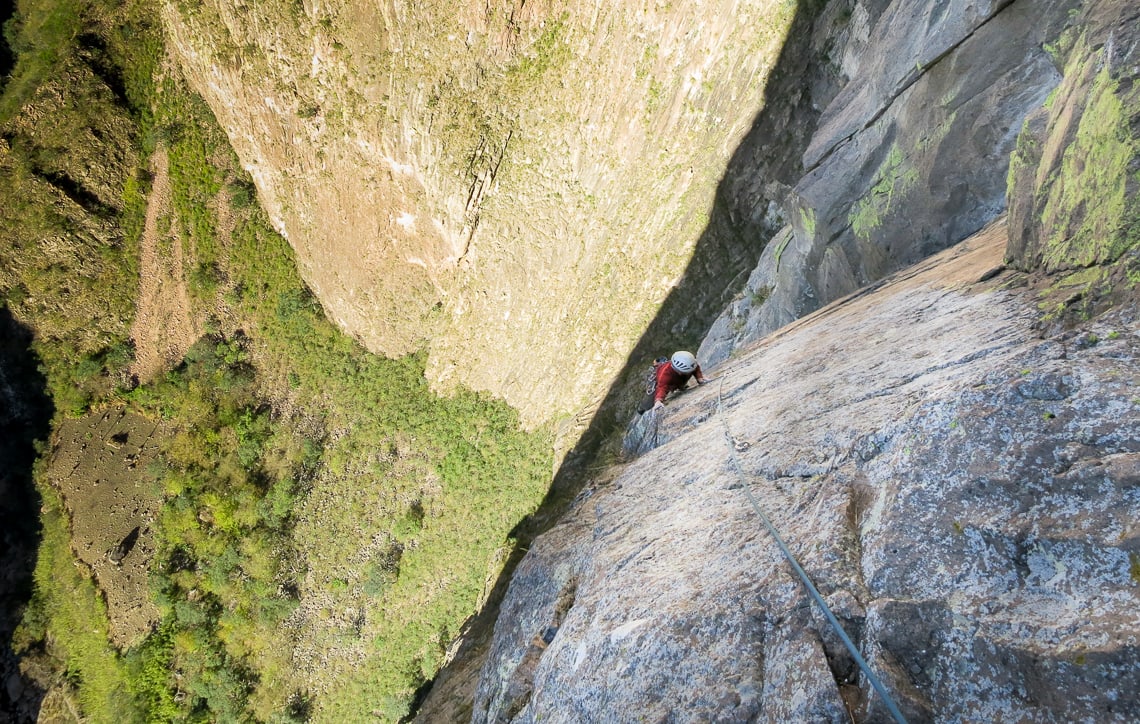
Rock-paper-scissors determines that I will lead the first pitch of the day, which is a stunning 5.12 on immaculate stone. Each pitch on this route would be a 5-star classic were they at any other crag. We start motoring through pitches, and Kalous is climbing better than the day before. As we reach the last pitch of the route, I’m somewhat sad that the experience is almost over. There is a sense of invincibility on these kinds of climbs, the feeling that you could do this for the rest of your life without any question.
Above us, we hear the laughter of our friends whispering in the late afternoon breeze.
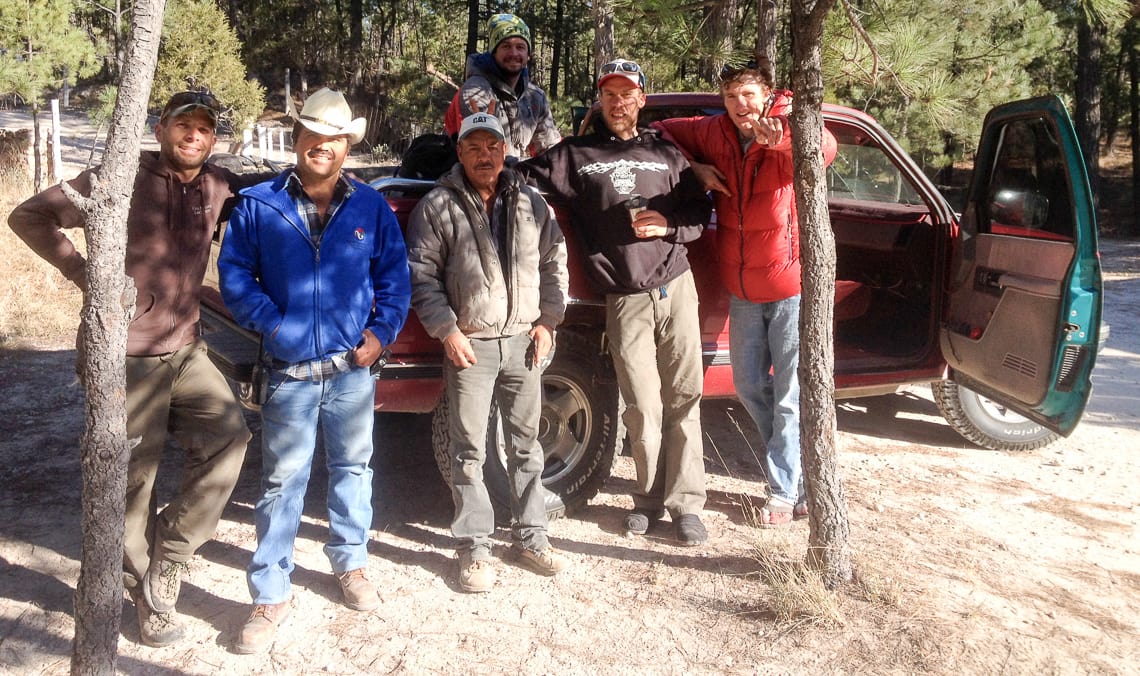
Justin had to get back to work and his family in Bozeman. Kalous also had “real-life” obligations back in Colorado. Kyle was busy planning for a summer full of mountain adventures while also running his coffee shop, Higher Ground, in Salt Lake City.
As for me, I kept driving north, grasping for the next climb, the next adventure, the next mission and purpose. Pushing harder and harder, with only the bleak reprieve of hanging Christmas lights to refill the bank account.
I have watched too many friends head into hills without thought or reason just because that’s what they have always known. I have been guilty of this approach, too. Why do some of us survive and others don’t?
I look back at this trip and find memories, feelings, and moments that seem obscured deep within the Copper Canyon below the walls and far away from my life now. Kyle and Justin are gone, Kalous is a full-time father and I am still trying to find my path with purpose and balance. I am a little closer than I was then, but in many ways only because of the pain and loss of my dear friends.
So much of Kyle and Justin remain alive within me, in these thoughts and memories that return as I write this story. I think about Kyle’s ability to connect with so many people and to find peace while in such intense situations. I think about Justin’s discreet yet very obvious sense of humor; his one-liners that still make my sides ache with laughter; his simple way of enjoying life.
Kalous was in danger of becoming a grumpy, bitter-old climber until he became a father. Now he is sweet and salty. And he’s renewed with this newfound passion.
I resent that my friends are gone, and I also hate that I have those feelings. I don’t want to be the guy who judges or resents my friends for their choices in the mountains because I know how it feels to be judged for decisions I’ve made in the mountains. Somehow death makes these feelings inescapable.
Clichés like “they were just following their passion” are what we all say in moments of loss and tragedy. Of course, that is just bullshit.
There is this dual nature of sublime meaning and utter absurdity in climbing mountains. Sending harder, bigger, more badass routes won’t make you a better, more humble, more gracious or happier human—yet we often approach those mountains like they can. There is no glory, no real answers, in sending and summits, yet we organize our entire lives around the myth that there are.
On the other hand, I’ve also experienced how mountains strip us down to our true selves. We see who we are, and we see who are partners really are, and they see us back. Kyle was one of those people who I got to see. This is the stuff that could never be conveyed on Instagram. It’s one reason why alpinism yields such complexity beyond summits.
Climbing can be an incredible catalyst for our growth. But I am beginning to realize that there’s a certain danger in making climbing the singular focus of your life because it can actually limit the opportunity for growth and reflection if you don’t stop, pause, breathe, and reflect.
El Gigante remains an important part of my life, not because of the climbing or the send, but because of the connection the four of us made on that wall. What I struggle with most is that I didn’t see the importance of this route till now.
update:
It’s with great sadness that we must report that Hayden Kennedy and Inge Perkins died on October 7, 2017.


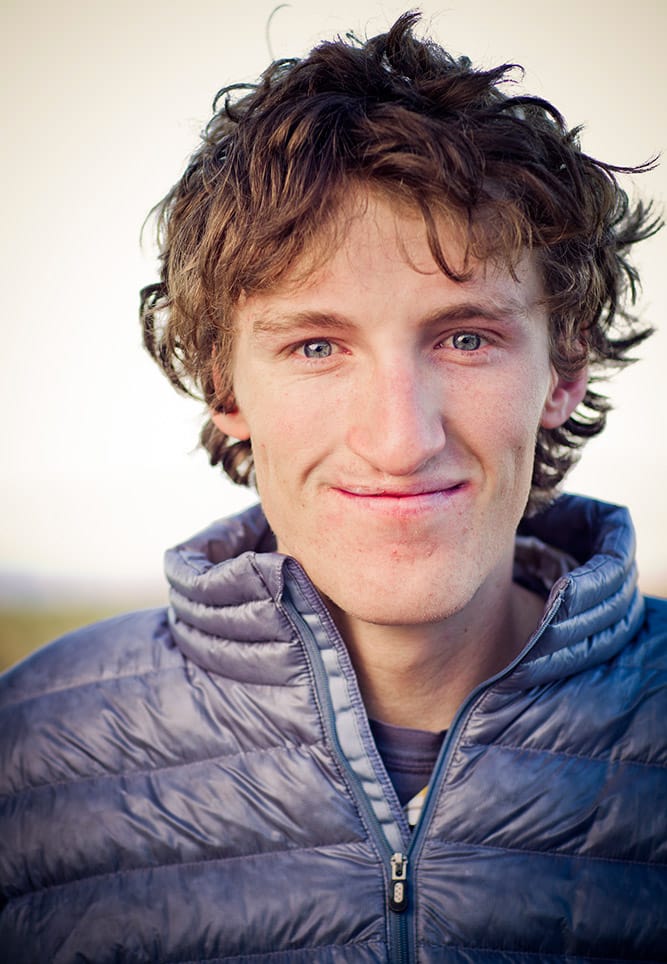

Beautifully written. Thank you.
I enjoyed this! Thanks 🙂
what an excellent read. thoughtful stuff, thanks.
This was fantastic. Cheers to both AB and HK for this piece.
What are the chances of recording HK read his article? I have thought with some past “Day I Sent” it would be cool to hear it in their voice.
This article brought me some peace and insight about recent friends dying in the mountains. Thank you so much for sharing 🙂
Hello Hayden,
i am very sorry for the loss of your friends.
The Hermosillo road is a very, very long haul to Basa. Next time, check out to get there from Chuauthemoc.
Pete, the German
and yes, the first ascent team still exists and we love stories like yours.
Here is something for the records: Bert is Belgian!!!!!!!!!!
Great piece, thank you
A subject that never seems to get traction. No one ever wants to talk about the dark side. Thanks for your honesty Hayden!
Stunning. This is an important piece that every climber should read–but especially the young badasses who think they have it all figured out.
Thank you for sharing this. We all have those special climbs that bubble up within minutes after the beer is poured with a good friend. They’re not necessarily the biggest, baddest & raddest climbs, but they’re some of the most precious. Kyle and Justin sound like truly amazing, uplifting people and a helluva good time.
Thanks for sharing!
Really powerful. Sending love to the Carbondale community ❤️
With a heavy heart, I regretfully share that Hayden Kennedy has passed away. May he be reunited with Justin and Kyle. Indeed, climbing is not about the summit or the tick or the onsight. It’s about the community and our climbing partners – it’s about the experiences we can share and the lessons we can take away. Praying for the Kennedy family.
Well written! I know CK and MK but never met HK and I am so saddened by the loss. Thank you for sharing!
This is an incredible piece of writing made even more poignant by the recent tragedy. I am blown away by the timing, the execution and the incredible potency here. My thoughts are with everyone that knew Hayden and Inge. The climbing world, hell, THE world, suffered yet another terrible loss
After reading this article, with intent, I have to report the deep sadness I feel for the author and his party. #HK _ RIP.
Sad to learn of Hayden’s untimely demise. I’m not a sentimental man, I’ve never been overly emotional, and I deal stoically and quietly with death and tragedy. But I’ve always felt it is a double-edged sword, I never get the soul-crushing lows, but nor do I get the glorious highs… I am always merely content. Perhaps that explains why I cannot match such a brilliant piece of truly passionate writing. He went too young, but he certainly crammed plenty into his short time on this earth.. hats off to a young man with bags of heart.
Excellent read!